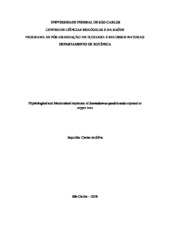| dc.contributor.author | Silva, Jaqueline Carmo da | |
| dc.date.accessioned | 2018-05-10T18:21:15Z | |
| dc.date.available | 2018-05-10T18:21:15Z | |
| dc.date.issued | 2018-03-09 | |
| dc.identifier.citation | SILVA, Jaqueline Carmo da. Physiological and biochemical responses of Scenedesmus quadricauda exposed to copper ions. 2018. Dissertação (Mestrado em Ecologia e Recursos Naturais) – Universidade Federal de São Carlos, São Carlos, 2018. Disponível em: https://repositorio.ufscar.br/handle/ufscar/9959. | * |
| dc.identifier.uri | https://repositorio.ufscar.br/handle/ufscar/9959 | |
| dc.description.abstract | Copper is an important metal for industry, and its threshold in natural ecosystems has increased since the industrial revolution. As a micronutrient, it is required in minute amounts (~10-8 molL-1 Cu2+ ions), but can be toxic in concentrations above that, causing great biochemical transformations in microalgae. This study aimed at investigating the physiology of Scenedesmus quadricauda, a cosmopolitan species, exposed to copper concentrations including those that trigger intracellular biochemical modifications. It was divided in two parts, one to investigate the general physiology of the microalgae and the other to investigate the photosynthetic process. Copper concentrations ranged from 0.1 to 25 µM, thus including environmentally important levels. Microalgae cultures were kept under controlled environmental conditions and monitored daily for cell density, in vivo chlorophyll a, and photosynthetic quantum yield (ΦM). After 96 h Cu exposure, cellular Cu concentration, total carbohydrates, proteins and lipids were determined. The results showed that cellular copper and chlorophyll a per cell increased proportionally to Cu concentration in the culture medium and that microalgae cell density was mostly affected at 2.5 µM Cu and above. Approximately 31% decrease in quantum yield was obtained at the highest Cu concentration (25 µM) in comparison with the control, but at a concentration 10 times lower (2.5 µM Cu), the highest biomolecule yield was obtained for carbohydrates and proteins, but not for lipids. Results of the second part showed that the photosynthetic parameters, chlorophyll per cell volume, and viability decreased as a function of the copper added, whereas biovolume and chlorophyll a per cell increased. The present results suggest that at the range of Cu concentration tested, copper inhibited S. quadricauda cell division and significantly affected the photosynthetic process. This study is a contribution to the understanding of the effects of environmentally significant copper concentrations in the physiology of S. quadricauda. | eng |
| dc.description.sponsorship | Coordenação de Aperfeiçoamento de Pessoal de Nível Superior (CAPES) | por |
| dc.language.iso | eng | eng |
| dc.publisher | Universidade Federal de São Carlos | por |
| dc.rights.uri | Acesso aberto | por |
| dc.subject | Microalga | por |
| dc.subject | Cobre | por |
| dc.subject | Carboidratos | por |
| dc.subject | Proteínas | por |
| dc.subject | Lipídios | por |
| dc.subject | Microalgae | eng |
| dc.subject | Copper | eng |
| dc.subject | Carbohydrates | eng |
| dc.subject | Proteins | eng |
| dc.subject | Lipids | eng |
| dc.subject | Photosynthesis | eng |
| dc.title | Physiological and biochemical responses of Scenedesmus quadricauda exposed to copper ions | eng |
| dc.type | Dissertação | por |
| dc.contributor.advisor1 | Lombardi, Ana Teresa | |
| dc.contributor.advisor1Lattes | http://lattes.cnpq.br/6737850858443813 | por |
| dc.description.resumo | O cobre é um metal importante para a indústria e seu limiar em ecossistemas naturais vem aumentando desde a revolução industrial. Como micronutriente esse elemento é necessário em pequenas quantidades (~10-8 mol L-1 Cu2+ íons livre), mas pode ser tóxico em concentrações acima disso, causando grandes transformações bioquímicas em microalgas. Este estudo teve como objetivo investigar a fisiologia de Scenedesmus quadricauda, uma espécie cosmopolita, exposta a concentrações de cobre, incluindo as que desencadeiam modificações bioquímicas intracelulares. Dividimos esta pesquisa em duas etapas, uma destinada a investigar a fisiologia geral da microalga e a outra o processo fotossintético. As concentrações de cobre testadas variaram de 0,1 a 25 μM, incluindo, portanto, níveis ambientalmente importantes. Os cultivos da microalga foram mantidos sob condições ambientais controladas. Na primeira etapa monitorou-se diariamente a densidade celular, clorofila a in vivo e rendimento quântico fotossintético (ΦM). Após 96 h de exposição ao Cu, foi determinada a concentração de Cu celular, carboidratos, proteínas e lipídios totais. Os resultados mostraram que o cobre celular e a clorofila a por célula aumentaram proporcionalmente à concentração de Cu no meio de cultura e que a densidade celular das microalgas foi principalmente afetada acima de 2,5 μM de Cu. Aproximadamente 31% do rendimento quântico diminuiu na maior concentração de Cu (25 μM) em comparação com o controle, mas em concentração 10 vezes menor (2,5 μM Cu), o maior rendimento de carboidratos e proteínas foi obtido. Os resultados da segunda etapa mostraram que os parâmetros fotossintéticos, clorofila a por unidade de volume celular e a viabilidade celular diminuíram em função do cobre adicionado, enquanto o biovolume e clorofila por celular aumentou. Os presentes resultados sugerem que, na gama de concentrações testadas, o cobre inibiu a divisão celular de S. quadricauda e afetou significativamente o processo fotossintético. Este estudo é uma contribuição para a compreensão dos efeitos do cobre na fisiologia e fotossíntese de S. quadricauda. | por |
| dc.publisher.initials | UFSCar | por |
| dc.publisher.program | Programa de Pós-Graduação em Ecologia e Recursos Naturais - PPGERN | por |
| dc.subject.cnpq | CIENCIAS BIOLOGICAS::ECOLOGIA | por |
| dc.ufscar.embargo | Online | por |
| dc.publisher.address | Câmpus São Carlos | por |
| dc.contributor.authorlattes | http://lattes.cnpq.br/7039615915524889 | por |

